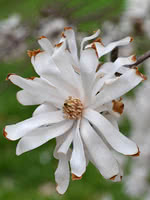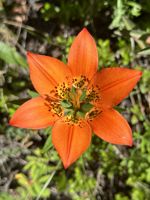Mon-Fri 9am - 5pm Mountain time
Royal Star Magnolia vs Wood Lily
Magnolia stellata Royal Star
Lilium philadelphicum
NOT AVAILABLE THIS SEASON - MIGHT RETURN
(we don't know if or when this product will be restocked)
CUSTOM GROW
The Royal Star Magnolia, or Star Magnolia, is an early-blooming, white fragrant flower. It has a form that resembles a starburst, hence the name. This multi-stemmed deciduous shrub is extremely popular and has won the prestigious Award of Garden Merit from the Royal Horticultural Society.
The Royal Star Magnolia attracts birds and butterflies to your garden, with their large, showy flowers blooming even before it’s foliage which features a medium green leaf. They prefer slightly acidic soils.
Wood Lily is a native perennial wildflower known for its vibrant, trumpet-shaped blooms in shades of orange to red. Its showy flowers appear mid-summer and are highly visible in meadows and prairies. The upward-facing flowers are an important nectar source for many pollinators, including native bees, butterflies, and hummingbirds.
Unlike most lilies, the Wood Lily’s flowers face upward rather than nodding. It is slow to establish and may take years before flowering, but once mature, it requires little maintenance. It is well-suited for pollinator gardens, naturalisation projects, prairie restoration, and open woodland plantings.
Wood Lily is the provincial flower of Saskatchewan and North America’s most widespread lily. Despite its wide natural range, populations have been declining. Habitat loss, overgrazing by deer, and unsustainable picking have reduced both its abundance and density across many regions. These pressures highlight the importance of protecting and restoring this once-common wildflower.
Royal Star Magnolia Quick Facts
Wood Lily Quick Facts
Toxicity: toxic to cats

